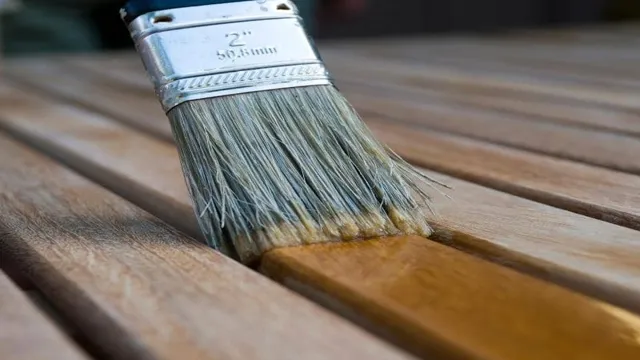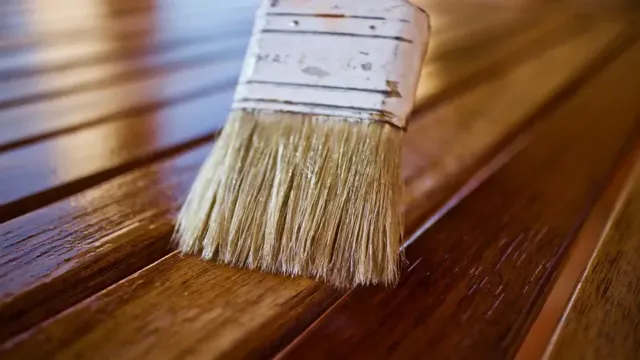Have you ever found yourself in a situation where you want to add a layer of lacquer to a polyurethane-coated object but not sure if it’s possible? Well, the good news is that it is possible to lacquer over polyurethane, but there are some key things you need to know before diving into the project. Lacquer and polyurethane are two different types of finishes that offer unique benefits and drawbacks. Lacquer is a quick-drying, easy-to-clean finish that provides a smooth, high-gloss appearance.
Polyurethane, on the other hand, is a durable, protective finish that is resistant to water and scratches. When it comes to lacquering over polyurethane, the success of the project depends on a few factors. First, it’s essential to ensure that the polyurethane has fully cured and is free of any wax or oil residue.
Second, you need to select the right type of lacquer that is compatible with the polyurethane. And finally, proper preparation and application techniques are crucial to achieving the desired finish. In this blog post, we’ll dive deeper into each of these factors and provide you with tips and tricks to ensure your lacquering over polyurethane project is a success.
So, whether you’re a DIY enthusiast or a professional woodworker, keep reading to learn all you need to know about lacquering over polyurethane.
Understanding the Materials
Can you lacquer over polyurethane? The answer is yes, but it requires some careful preparation before you can start. Polyurethane can be quite an effective sealant and will provide an extra layer of protection to your wooden surfaces. However, if you want to add a glossy finish to your wood, you can apply lacquer over the top.
Before doing this, you need to ensure that the surface is clean and free from dust and debris. You should also sand the surface lightly to remove any bumps or rough spots. Once the surface is smooth, you can apply the lacquer in thin layers, making sure to let each layer dry completely before applying the next.
It is essential to be patient and take your time with this process because applying too much lacquer at once can cause it to bubble or peel. By taking the necessary precautions, you can achieve a beautiful, glossy finish on your wooden surfaces.
What is Lacquer?
Lacquer is a coating material that has been used for centuries to protect and decorate surfaces such as wood, metal, and ceramics. It is made from a mixture of natural or synthetic resins, solvents, and various additives. Lacquer provides a durable, glossy finish that can resist abrasion, water, and chemicals.
There are two main types of lacquer: nitrocellulose and acrylic. Nitrocellulose lacquer is made from cellulose nitrate and is fast-drying, while acrylic lacquer is made from acrylic polymers and is more durable and resistant to yellowing. Lacquer can also come in a variety of colors and can be adapted to different finishes such as matte or satin.
It is a versatile material appreciated by artists, craftsmen, and designers for its beauty and practicality. Lacquer can elevate any piece of furniture or artwork with its unique sheen and color, and it remains a popular choice in contemporary design.

What is Polyurethane?
Polyurethane is a versatile material that is commonly used in various applications. It is a synthetic polymer that is made by combining diisocyanates and polyols. This material has excellent properties such as durability, flexibility, and resistance to heat, chemicals, and abrasion.
Its versatility stems from the fact that it can be formulated to meet different specifications and requirements. Polyurethane is commonly used to make foam insulation, furniture, car parts, footwear, coatings, adhesives, and sealants, to name a few. Its ability to provide unique characteristics to end products make it a go-to choice for many industries.
However, it is important to note that the use of polyurethane can have negative environmental impacts as it is derived from non-renewable resources and its disposal poses challenges.
Determining Compatibility
Are you wondering if you can lacquer over polyurethane? Well, it depends on a few things. First, you need to determine if the polyurethane is oil-based or water-based. If it’s oil-based, then you can lacquer over it without any issues.
However, if it’s water-based, then you need to be cautious because lacquer is a solvent-based product, which can soften or dissolve the water-based polyurethane. So, before proceeding, you should test the lacquer in a small, inconspicuous area to ensure that it doesn’t cause any adverse reactions. Additionally, it’s important to note that lacquer will not adhere properly to a surface that has been waxed or polished.
So, if your polyurethane has a wax or polish on it, you should remove it before applying the lacquer. Overall, while it is possible to lacquer over polyurethane, it’s crucial to determine compatibility and take the necessary precautions to ensure a successful outcome.
Factors to Consider
When it comes to starting a new relationship, determining compatibility is essential. There are many factors to consider, such as values, interests, lifestyles, and goals. It’s important to have open and honest communication with your potential partner to see if you share similar beliefs and aspirations.
Another important factor is chemistry and attraction. While it’s not everything, physical and emotional attraction can play a significant role in a successful relationship. It’s also essential to consider how each person’s personality traits and communication styles fit together.
Are you both willing to compromise and work through difficulties together? These are all important questions to ask when determining compatibility in a new relationship. Ultimately, finding someone who shares your values and vision for the future can lead to a fulfilling and lasting partnership.
Testing for Compatibility
Determining compatibility is crucial in any aspect of life, and technology is no exception. Testing for compatibility helps ensure that any software or hardware will function properly with other systems and devices. Compatibility issues can cause frustrating and time-consuming problems such as crashes, glitches, and malfunctions.
To avoid these issues, it is important to thoroughly test for compatibility before implementing any new system or device. This can involve testing different configurations, operating systems, and hardware components to determine compatibility. It is also important to consider future updates and upgrades when testing for compatibility.
By taking the time to determine compatibility, you can save time, money, and frustration in the long run.
Lacquering Over Polyurethane
Have you ever wondered if it’s possible to lacquer over polyurethane? Well, the answer is yes! You can absolutely apply a layer of lacquer over polyurethane. However, it’s important to note that you should always do a test run first and ensure that the finish is fully cured. It’s best to wait at least 72 hours after applying the polyurethane before adding the lacquer layer.
Additionally, it’s important to use a high-quality lacquer that is compatible with polyurethane. This will give you the best results and ensure that the two finishes bond properly. So, if you want to add a little extra shine to your polyurethane finish, go ahead and try lacquering over it – just be sure to take the proper steps to ensure a smooth and successful application.
Preparing the Surface
When it comes to lacquering over polyurethane, it is important to properly prepare the surface beforehand. This means ensuring that the polyurethane is fully cured, clean, and free of any dust or debris. It is also important to lightly sand the surface to create a rough texture that will help the lacquer adhere better.
Using a high-quality primer can also help improve adhesion and provide a smooth base for the lacquer to be applied. Once the surface is properly prepared, you can apply the lacquer in thin coats, taking care not to apply too much at once and allowing sufficient time between coats for it to dry and cure. By properly preparing the surface and taking care during the application process, you can achieve a beautiful and long-lasting finish on your polyurethane surface.
Application Process
If you’re considering lacquering over polyurethane, there are a few things you should keep in mind. First, be aware that polyurethane is notoriously difficult to coat with other finishes. This is because it has a very smooth surface, which can make it hard for new coatings to adhere properly.
To ensure the best results, you’ll need to thoroughly clean the surface of any dirt, dust, or grease before beginning. You may also need to use a chemical stripper to remove any existing coatings. Once the surface is clean, you can apply a thin coat of lacquer using a sprayer or brush.
Be sure to follow the manufacturer’s instructions for application and drying times. Lacquer dries quickly, so you may need to work in small sections to avoid it drying before you’re finished. With patience and careful application, you can successfully lacquer over polyurethane for a beautiful, glossy finish.
So, if you want to give your furniture or woodwork a new lease of life, give it a go!
Finishing Touches
If you’re looking to add an extra layer of protection to your polyurethane finish, consider lacquering over it. This can provide added durability and shine to your already sturdy finish. However, it’s important to note that lacquer and polyurethane don’t always play well together, so it’s crucial to use a compatible lacquer for the best results.
It’s also recommended to lightly sand the polyurethane and clean the surface before applying the lacquer to ensure a smooth and even application. Once applied, allow ample drying time and consider applying a second coat for added protection. With this finishing touch, your polyurethane finish will not only look great but also last longer.
Conclusion
In conclusion, asking whether you can lacquer over polyurethane is like asking whether you can wear a tuxedo over your bathing suit. Technically, it’s possible, but it’s not recommended and could lead to some awkward results. It’s best to stick with one finish or the other, and choose the one that will provide the look and durability you need for your project.
Don’t be afraid to experiment and try new things, but always do your research first and make sure you’re using the right products for the job.
FAQs
What is the difference between lacquer and polyurethane?
Lacquer and polyurethane are both types of clear finishes, but they are made from different materials. Lacquer is made from nitrocellulose and is known for its fast-drying properties, while polyurethane is made from synthetic resins and is a more durable finish.
Can you apply lacquer over polyurethane?
It is not recommended to apply lacquer over polyurethane. The surfaces may not bond well, and the finish may crack or peel over time.
Can you apply polyurethane over lacquer?
It is possible to apply polyurethane over lacquer, but you must first remove any wax or polish from the surface and sand it lightly to ensure good adhesion.
How many coats of lacquer or polyurethane should I apply?
It depends on the level of protection and shine you want. Typically, 2-3 coats of lacquer or polyurethane are needed for a smooth and durable finish.
Can you use lacquer or polyurethane on outdoor furniture?
Polyurethane is a better choice for outdoor furniture as it is more resistant to water and UV rays. However, lacquer can also be used if it is applied in multiple layers and sealed with a UV-resistant topcoat.
How long does it take for lacquer or polyurethane to dry?
The drying time depends on several factors such as humidity, temperature, and coat thickness. Generally, lacquer dries faster than polyurethane and can be recoated in 2-3 hours, while polyurethane takes 6-8 hours to dry.
What is the best way to apply lacquer or polyurethane?
It is best to apply lacquer or polyurethane with a brush, foam pad, or sprayer. Make sure to apply even coats and sand lightly between each layer for a smooth finish.






